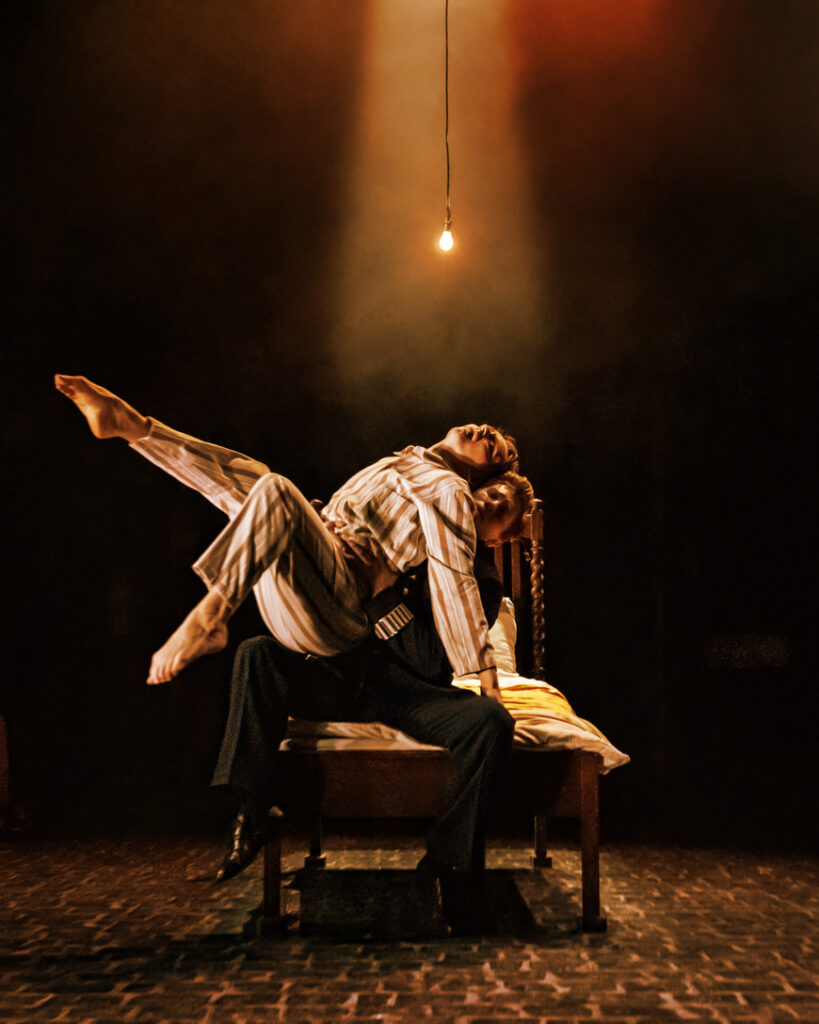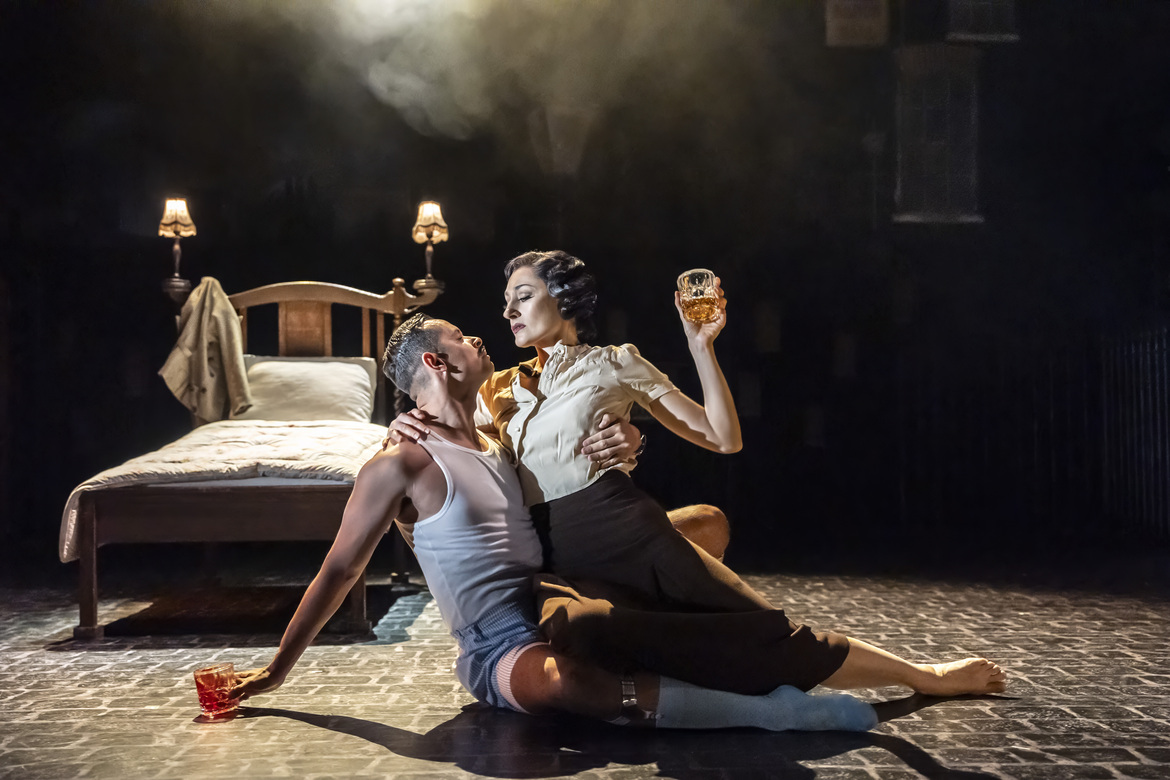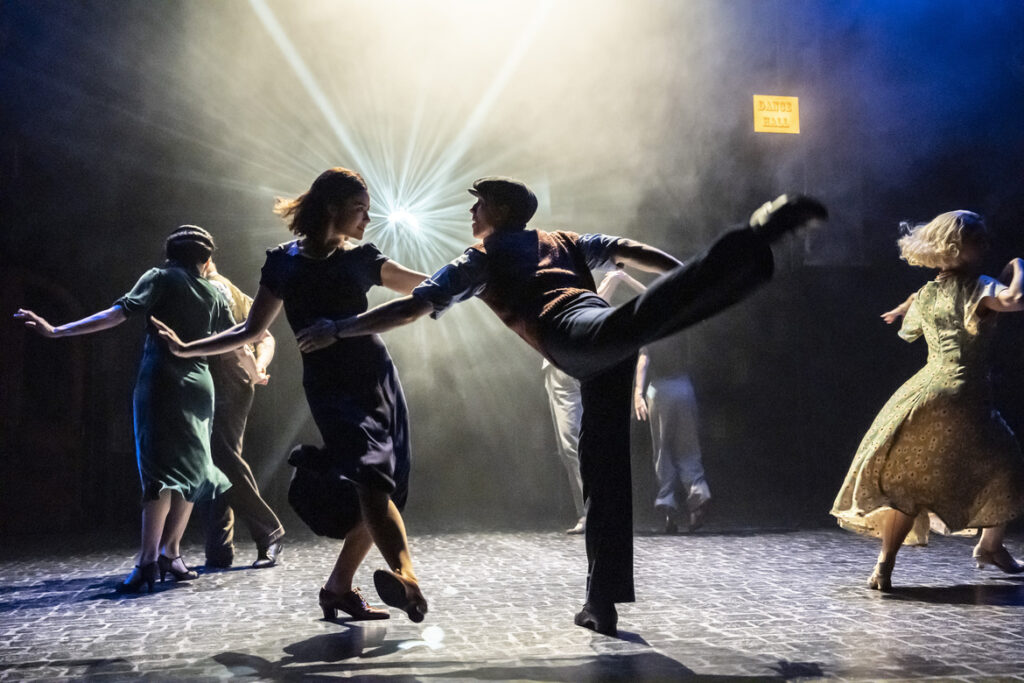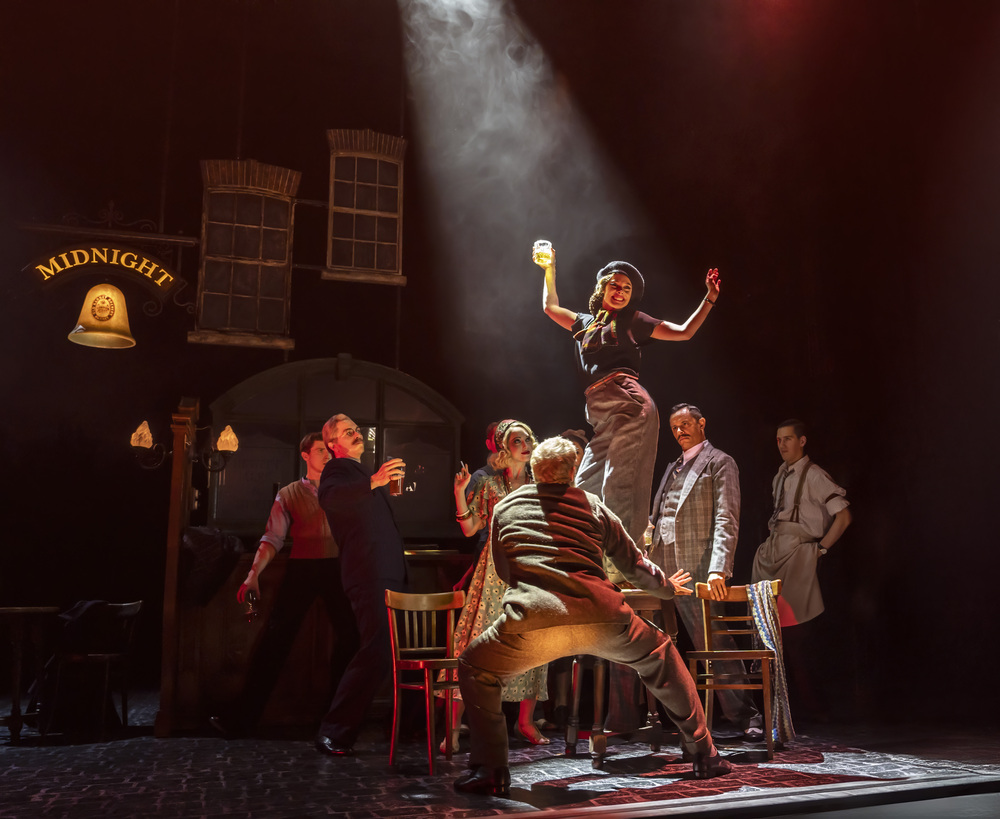Review by Simon Jenner, July 30 2025
Brighton returns to Brighton. Again. Patrick Hamilton (1904-62) famed for his two brilliant melodramas Rope (1929) and Gaslight (1938) was a novelist the equal of close contemporaries Evelyn Waugh, Graham Greene, Henry Green and Anthony Powell. Living in Brighton his trilogy Twenty Thousands Streets Under the Sky (1929-34) and subsequent novels are the stuff of Sir Matthew Bourne’s latest work: his brilliant conflation The Midnight Bell, now pauses at Theatre Royal, Brighton before shooting off to another city of dreams. It’s as dazzling as it was in 2021.


Liam Mower as Albert and Edwin Ray as Frank. Photo Credit: Johan Persson
Dreams it is. Bourne’s crafted a superb distillation of Hamilton’s world, along with another Hamilton devotee, composer Terry Davies, who avoids pastiche and studs the work with period songs including Gershwin’s ‘The Man I Love’ given to a man about a man, but is sparing of these and creates a memorable contemporary palette, with strikingly individual sonorities for each of the five couples (Bourne talks of six, but it’s five stories we get here).
Bourne devises, directs and with the company choreographs to Davies’ music and Paule Constable’s magically recessional lighting, first gleaming in a swept gallery of windows to evoke Hamilton’s title. There’s a gloved collaboration with Lez Brotherston’s set – and period costume designs – that feature everything from a central bed with that perspective of lonely lit windows where everyone comes to some kind of reckoning.
More, the most ubiquitous is the bar set sliding in and out with tables lit in 1930s style and pendant above various neons of ‘Rooms’ for seedy assignations’ or ‘Telephone’ with quotes from boxes but whisked away as tiny gestures. Things shoot out from the wings, there’s suddenly the lighting effect of cobbles in the rain, a lonely bench, a Lyons Tea House sign upstage where couples downstage congregate in chintzy-laid tables. It’s a remarkable set, fluid as the dancers.
Sound designer Paul Groothius has much to do with those songs, various actor/dancers mime spotlit by Constable like ‘Pennies From Heaven’ for instance. Associate artistic director and choreographer Etta Murfitt attends to the way this fits with each theatre.
The dancers who’ve been with New Adventures over 25 years contribute and develop their own choreographic moves.

We start with the actual novel The Midnight Bell the first of that trilogy. It’s the pub they all converge on and though it’s set in the early 1930s Mr Gorse for instance comes from The Gorse trilogy of 1952-55. It’s like we’re getting a crash-course in Hamilton’s fictive distillation.
Here Andy Monaghan’s transcendently fluid Bob, the lovelorn young bartender whom Ella the other bar tender is in love with, but she’s not cute or damaging enough (Monaghan was Frank, below, last time). He falls Ashley Shaw’s fascinating prostitute Jenny Maple: older, sexually experienced beyond his imaginings, Shaw’s character shows both aloofness and a lack of interest in Bob or anyone else. It’s only when she’s assailed by others that Bob might prove useful, even freshly desirable. The nervous dance around each other lasting most of the narrative embellishes Bob’s fantasies of her as they dance, but not hers of what she might want herself.
Particularly striking are Monaghan’s solos and the dance around the solitary bench after Bob’s rescued Jenny. Shaw owns a shimmering set of vanish moments, as if she’s herself a dream. Davies’ music deploys the violin, often used with the marimba, redolent not only of film music but Korngold’s 1945 Violin Concerto in D which quotes from his own film scores. It’s a hypnotic as the couples’ disjunct dreams.
There’s a couple Bourne’s added and in a way it’s the happiest. Returning from the 2021 cast Liam Mower’s West End chorus boy Albert picks up with handsome clean-cut Frank – Edwin Ray’s anchor as they easily, rapturously and uncomplicatedly fall for each other. It’s the most touching and exhilarating coupling here, and Hamilton, notably anti-homophobic, would have been delighted. Frank has a secret though, revealed at the Lyons Corner shop. Can their love survive it? This is the classic couple in their pas de deux, their beautifully equalised mirror choreography each subtly different.
Danny Reubens’ unhappy George Harvey Bone is a solitary bearded older man, as suggested, prone to epileptic fits when he’s afterwards visited by enormous clarity. He’s labelled here rather creatively – despite enacting those grand mals – a schizophrenic. His obsession’s for Cordelia Braithwaite’s Netta Landon, a wannabe out-of-work but beautiful actress. She’s the most exuberant performer, fascinating everyone with her powers of drawing male and female gaze. Her dances too are solitary, aren’t notably linked to Reubens’ Bone whose own choreography is more charactered and disturbing than exuberant like Monaghan. Yet of course he’s consummate, and can match Braithwaite’s wild flights. There’s a denouement however, then another leaving Bone dumbfounded.
Another returnee from 2021 in the same role is Reece Causton’s wealthy Mr Eccles – we never know his first name – seems to offer Ella escape, love even. Hannah Kremer’s Ella, despairing of beautiful Bob, accepts the moneyed Eccles and is even flattered when he finally proposes in that same Lyons Shop, other characters clapping and another, Miss Roach, laying a hand on her shoulder, perhaps a premonition. The piano score used to define this couple is Eccles’ control freakery, trying to sleep with Ella because he thinks he’s bought her. Causton superbly invokes this clockwork martinet, continuously pulling Kremer’s nervous, premonitory Ella back onto the bench. She has to break away. Can she? Kremer conveys this low-self-esteem young woman, always subfusc to action, suddenly blaze out her own longings, and the upsetting of the clockwork freakery is a delight.
Two others from the 2021 cast are sublime. Glenn Graham’s Ernest Ralph Gorse replaces someone from an earlier volume with Miss Roach the 1947 hero of The Slaves of Solitude. Unlike everyone else Michela Meazza’s Roach, who’s come down from London to work away from the Blitz and after, is more self-aware, intelligently alert to manipulation. She’s lonely and in Meazza’s poise and sudden spasms of passion gives desire the sway early on, legs and body twirling in wild abandon; even though this Gorse steals from her. Graham like Causton has a superbly mannered quality, all seeming and sliding surface, false élan and scheming. Miss Roach sees this early on, and her solution is as exhilarating as it is funny, though colliding on that bed with another less equal couple.
The overall narrative arc, wonderfully clear even if you don’t know all the characters (we could have done with a further key) is timelessly compelling: partly because it’s locked in time. Partly because Hamilton’s narratives speak again today as his fiction finds great favour again. Above all though the choreographic storytelling, the selection of stories realised by individually dancers to an outstanding set and score, all driven by Bourne’s conception, mark this as an outstanding ballet by any standards. One that like Hamilton will last.
Devised and directed by Matthew Bourne, Choreography by Matthew Bourne and the Company, based on the works of Patrick Hamilton. Music by Terry Davies, Lighting Design Paul Constable, Set and Costume Designs Lez Brotherston, Sound Design Paul Groothius, Associate Artistic Director and Choreographer Etta Murfit
Ensemble. Photo Credit: Johan Persson



